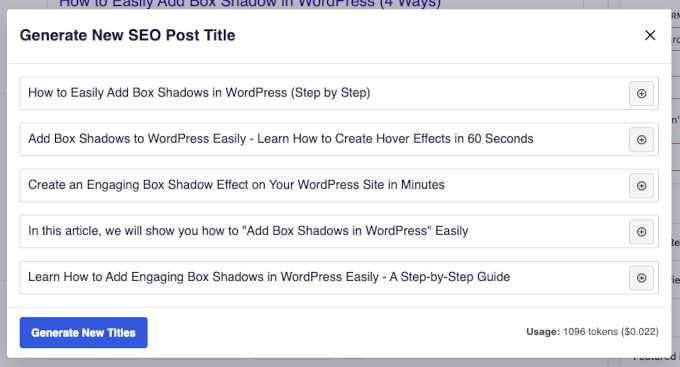A website title is an HTML tag that tells visitors and search engines what a web page or article is about. It is also commonly known as a title tag or an SEO title.
You will see the website title in the tab at the top of your web browser. In the search results, the title tag is the link you click to visit a search result.
An optimized website title tag helps people identify your WordPress site in search results and can enhance your click-through rates. Plus, it can improve search engine rankings by helping Google index and rank your web pages more effectively.

What Is a Title Tag?
A website title is wrapped in HTML code <title> tags. This HTML element is your post’s SEO title and is also known as the meta title or title tag.
The blue link that users click on in Google or other search engines is the website title set in the <title> tags:

Note that your website title or SEO title tag is not the same as your H1 post title. For more details, you can see our guide to SEO title vs. H1 post title.
Why Is the Website Title Tag Important for SEO?
A good title tag can make your website stand out in the search engine results pages (SERPs) and get more traffic to your site. If your content has a relevant and catchy title, then it’s more likely to show up in search results.
That’s important because when people search, they usually click on the websites that sound most interesting or will help them solve their problems quickly.
A website title tag also helps Google index and rank your web page’s content effectively. It tells Google what your content is about so that it can show your content to the right users based on the keywords they search for.
You can use our headline analyzer tool to make sure that your website post and page titles are irresistible to both search engines and users.
The website title is an important part of your overall search engine optimization (SEO) strategy. You can learn more in our complete WordPress SEO guide.
Note: Keep in mind that Google may rewrite your title tag and display something different in the search results. In fact, this happens with up to 60% of all website titles.
This is more likely to happen if your title tag is different from the H1 title within your website content, so it’s a good idea to keep them the same whenever possible.
How to Change Your Website Title in WordPress
The best way to customize your website title/title tag is All in One SEO (AIOSEO), the best SEO plugin for WordPress.
When you are making or editing a post or page, you will have an ‘AIOSEO Settings’ area below the post content. Here, you will find a section called ‘Post Title’ where you can customize the SEO title.

You will also see a preview of how the title will look in a Google search and the number of characters you used so that you don’t get cut off in the search results.
Note: The default SEO title is the H1 post title followed by a separator and the name of your WordPress website. Remember, this doesn’t have to be the same as your website title tag.
In this section, you can also customize your title using smart tags or even insert emojis into your SEO post title with just a couple of clicks.

All in One SEO also comes with an OpenAI integration that can generate different website title suggestions.
For more details, you can see our guide on how to write powerful headlines using AI.

We hope this article helped you learn more about website titles/title tags in WordPress. You may also want to see our Additional Reading list below for related articles on useful WordPress tips, tricks, and ideas.
If you liked this article, then please subscribe to our YouTube Channel for WordPress video tutorials. You can also find us on Twitter and Facebook.
Additional Reading
- SEO Title vs H1 Post Title in WordPress: What’s the Difference?
- How to Easily Add Title Attribute to Images in WordPress
- How to Add Keywords and Meta Descriptions in WordPress
- How to Properly Use Heading Tags in WordPress (H1-H6 Explained)
- How to Use Headline Analyzer in WordPress to Improve SEO Titles



